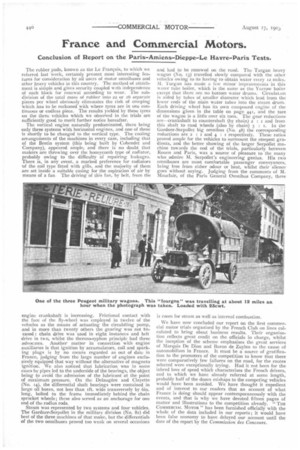France and Commercial Motors.
Page 6

If you've noticed an error in this article please click here to report it so we can fix it.
Conclusion of Report on the Paris.-Amiens-Dieppe-Le Havre-Paris Tests.
The rubber pads, known as the Le Francais, to which we referred last week, certainly present most interesting features for consideration by all users of motor omnibuses and other heavy vehicles in this country. The method of attachment is simple and gives security coupled with independence of each block for renewal according to wear. The sub-. division of the total mass of rubber into 22 or 26 separate pieces per wheel obviously eliminates the risk of creeping which has to be reckoned with where tyres are in one continuous or endless piece. The results yielded by these tyres on the three vehicles which we observed in the trials are sufficiently good to merit further notice hereafter,
The vertical engine naturally predominated, there being only three systems with horizontal engines, and one of these is shortly to be changed to the vertical type. The cooling arrangements of the machines in every case, including that of the Bretin system (this being built by Cohendet and Company), appeared ample, and there is no doubt that makers are throwing over the honeycomb type of radiator, probably owing to the difficulty of repairing leakages. There is, in any event, a marked preference for radiators 'of the coil type fitted with gills, and the majority of them are set inside a suitable casing for the aspiration of air by means of a fan. The driving of this fan, by belt, from the engine crankshaft is increasing. Frictional contact with the face of the fly-wheel was employed in twelve of the vehicles as the means of actuating the circulating pump, and in more than twenty others the gearing was not tncased : chain drive was used in eight instances and belt drive in two, whilst the thermo-syphon principle had three advocates. Another matter in connection with engine auxiliaries is that ignition by accumulators, coil and sparking plugs is by no means regarded as out of date in France, judging from the large number of engines exclusively equipped that way without the alternative of magneto ignition. We also noticed that lubrication wns in some cases by pipes led to the underside of the bearings, the object being to avoid the admission of the lubricant at the point of maximum pressure. On the Delaugere and Clayette (No. 14), the differential shaft bearings were contained in large oil boxes, not less than if t. wide transversely by 6in, long, bolted to the frame immediately behind the chain sprocket wheels; these also served as an anchorage for one end of the radius rods.
Steam was represented by two systems and four vehicles. The Gardner-Serpollet in the military division (No. 82) did best of the three machines of that make, but the differentials of the two omnibuses proved too weak on several occasions
and had to be renewed on the road. The Turgan heavy wagon (No. 13) travelled slowly compared with the other vehicles owing to its having to obtain water every 12 miles. M. TurE,ran has made a few minor improvements in this water tube boiler, which is the same as the Yarrow boiler except that there are no bottom water drums. Circulat.on is aided by tubes of smaller diameter which lead from the lower ends of the main water tubes into the steam drum. Each driving wheel has its own compound engine of the dimensions given in the table on page 441, and the tare of the wagon is a little over six tons. The gear reductions are—crankshaft to countershaft (by chain) 2 : i and from this shaft to road wheels (also by chain) 3 1. In the Gardner-Serpollet big omnibus (No. 48) the corresponding reductions are 2 : i and 4 : i respectively. These ratios proved ample for the vehicles to surmount the steepest gradients, and the better showing of the larger Serpollet machine towards the end of the trials, particularly between Rouen and Paris, was a source of pleasure to the many who admire M. Serpollet's engineering genius. His two omnibuses are most comfortable passenger conveyances, being free from either odour or heat, whilst their silence goes without saying. Judging from the comments of M. Mauclair, of the Paris General Omnibus Company, there
is room for steam as well as internal combustion.
We have now concluded our report on the first commercial motor trials organised by the French Club on lines calculated to bring about business results. Their organisation reflects great credit on the officials in charge, whilst the inception of the scheme emphasises the great services of Marquis De Dion and Baron de Zuylen to the cause of automobilism in France. It must be a source of gratification to the promoters of the competition to know that there were comparatively few failures on the road, for the routes selected were exceptionally trying. Had it not been for the inbred love of speed which characterises the French drivers, and to which we have already referred at some length, probably half of the dozen mishaps to the competing vehicles would have been avoided. We have thought it expedient and of interest to our readers that an account of what France is doing should appear contemporaneously with the events, and that is why we have devoted fifteen pages of matter and illustrations to the competition already. "THE COMMERCIAL MOTOR" has been furnished officially with the whole of the data included in our reports ; it would have been false economy to have delayed our account until the date of the report by the Commission des Concours.
















